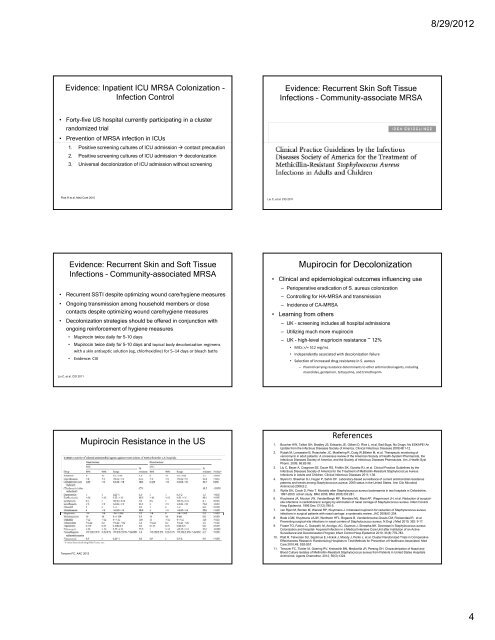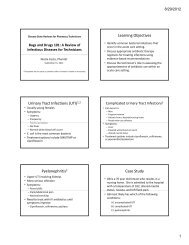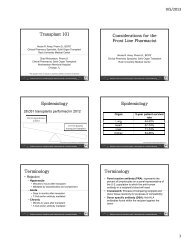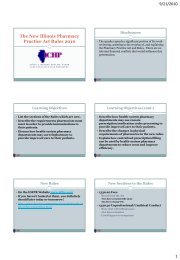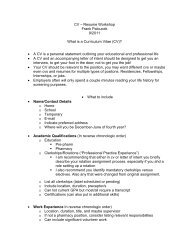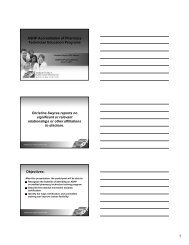Presentation Outline ICHP Annual Meeting September 13-15
Presentation Outline ICHP Annual Meeting September 13-15
Presentation Outline ICHP Annual Meeting September 13-15
Create successful ePaper yourself
Turn your PDF publications into a flip-book with our unique Google optimized e-Paper software.
Evidence: Inpatient ICU MRSA Colonization -<br />
Infection Control<br />
• Forty-five US hospital currently participating in a cluster<br />
randomized trial<br />
• Prevention of MRSA infection in ICUs<br />
1. Positive screening cultures of ICU admission � contact precaution<br />
2. Positive screening cultures of ICU admission � decolonization<br />
3. Universal decolonization of ICU admission without screening<br />
Platt R et al. Med Care 2010<br />
Evidence: Recurrent Skin and Soft Tissue<br />
Infections – Community-associated MRSA<br />
• Recurrent SSTI despite optimizing wound care/hygiene measures<br />
• Ongoing transmission among household members or close<br />
contacts despite optimizing wound care/hygiene measures<br />
• Decolonization strategies should be offered in conjunction with<br />
ongoing reinforcement of hygiene measures<br />
• Mupirocin twice daily for 5-10 days<br />
• Mupirocin twice daily for 5-10 days and topical body decolonization regimens<br />
with a skin antiseptic solution (eg, chlorhexidine) for 5–14 days or bleach baths<br />
• Evidence: CIII<br />
Liu C, et al. CID 2011<br />
Tenover FC. AAC 2012<br />
Mupirocin Resistance in the US<br />
Evidence: Recurrent Skin Soft Tissue<br />
Infections – Community-associate MRSA<br />
Liu C, et al. CID 2011<br />
Mupirocin for Decolonization<br />
• Clinical and epidemiological outcomes influencing use<br />
– Perioperative eradication of S. aureus colonization<br />
– Controlling for HA-MRSA and transmission<br />
– Incidence of CA-MRSA<br />
• Learning from others<br />
– UK – screening includes all hospital admissions<br />
– Utilizing much more mupirocin<br />
– UK - high-level mupriocin resistance ~ 12%<br />
• MICs >/= 512 mg/mL<br />
• Independently associated with decolonization failure<br />
• Selection of increased drug resistance in S. aureus<br />
– Plasmid carrying resistance determinants to other antimicrobial agents, including<br />
macrolides, gentamicin, tetracycline, and trimethoprim<br />
References<br />
1. Boucher HW, Talbot GH, Bradley JS, Edwards JE, Gilbert D, Rice L, et al. Bad Bugs, No Drugs: No ESKAPE! An<br />
Update from the Infectious Diseases Society of America. Clinical Infectious Diseases 2009;48:1–12.<br />
2. Rybak M, Lomaestro B, Rotschafer JC, Moellering R.,Craig W,Billeter M, et al. Therapeutic monitoring of<br />
vancomycin in adult patients: A consensus review of the American Society of Health-System Pharmacists, the<br />
Infectious Diseases Society of America, and the Society of Infectious Diseases Pharmacists. Am J Health-Syst<br />
Pharm. 2009; 66:82-98.<br />
3. Liu C, Bayer A, Cosgrove SE, Daum RS, Fridkin SK, Gorwitz RJ, et al. Clinical Practice Guidelines by the<br />
Infectious Diseases Society of America for the Treatment of Methicillin-Resistant Staphylococcus Aureus<br />
Infections in Adults and Children. Clinical Infectious Diseases 2011;1–38.<br />
4. Styers D, Sheehan DJ, Hogan P, Sahm DF. Laboratory-based surveillance of current antimicrobial resistance<br />
patterns and trends among Staphylococcus aureus: 2005 status in the United States. Ann Clin Microbiol<br />
Antimicrob 2006;5:2.<br />
5. Wyllie DH, Crook D, Peto T. Mortality after Staphylococcus aureus bacteraemia in two hospitals in Oxfordshire,<br />
1997-2003: cohort study. BMJ 2006; BMJ 2006;333:281.<br />
6. Kluytmans JA, Mouton JW, VandenBergh MF, Manders MJ, Maat AP, Wagenvoort JH, et al. Reduction of surgicalsite<br />
infections in cardiothoracic surgery by elimination of nasal carriage of Staphylococcus aureus. Infect Control<br />
Hosp Epidemiol. 1996 Dec;17(12):780-5.<br />
7. van Rijen M, Bonten M, Wenzel RP, Kluytmans J. Intranasal mupirocin for reduction of Staphylococcus aureus<br />
infections in surgical patients with nasal carriage: a systematic review. JAC 2008;61:254.<br />
8. Bode LGM, Kluytmans JAJW, Wertheim HFL, Bogaers B, Vandenbroucke-Grauls CM, Roosendaal R, et al.<br />
Preventing surgical-site infections in nasal carriers of Staphylococcus aureus. N Engl J Med 2010; 362: 9–17.<br />
9. Fraser TG, Fatica, C, Scarpelli, M, Arroliga, AC, Guzman J, Shrestha,NK. Decrease in Staphylococcus aureus<br />
Colonization and Hospital- Acquired Infection in a Medical Intensive Care Unit after Institution of an Active<br />
Surveillance and Decolonization Program Infect Control Hosp Epidemiol 2010; 31(8):779-783.<br />
10. Platt R, Takvorian SU, Septimus E, Hickok J, Moody J, Perlin J, et al. Cluster Randomized Trials in Comparative<br />
Effectiveness Research: Randomizing Hospitals to Test Methods for Prevention of Healthcare-Associated. Med<br />
Care 2010;48: S52–S57.<br />
11. Tenover FC, Tickler IA, Goering RV, Kreiswirth BN, Mediavilla JR, Persing DH. Characterization of Nasal and<br />
Blood Culture Isolates of Methicillin-Resistant Staphylococcus aureus from Patients in United States Hospitals<br />
Antimicrob. Agents Chemother. 2012, 56(3):<strong>13</strong>24.<br />
8/29/2012<br />
4


